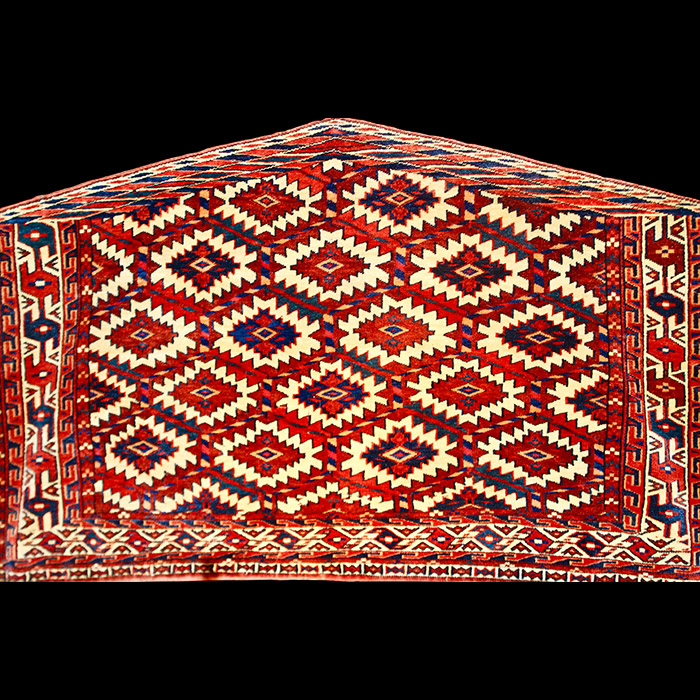Clay Stewart Collection of Türkmen Textiles
15. Türkmen Ýomut asylmak (asmalyk) ceremonial animal trapping
Ca. 1870. Size: 4ft 2in x 2ft 4in
Ca. 1870. Size: 4ft 2in x 2ft 4in

Asmalyk is the common western misspelling of "a thing to be hung”, i.e., an ceremonial apotropaic animal trapping used in the Türkmen wedding camel procession. Asylmak is the currently accepted modern spelling in the Turkmen - English dictionary. I will use the asmalyk version. They may be piled or embroidered and are usually five-sided, but some are seven-sided. Ýomut Türkmen asmalyks are the most common, followed by the Téké. Asmalyks were usually made in pairs to decorate both flanks of the lead wedding camel and were later hung in her new father in law’s domed felt-covered tent. Asma is the Turkmen word for ‘heaven’. This trapping, both decorative and defensive, was never intended for use as a bag.
8 x 20 =160 Ghiordes (Turkish) knots, pulled nearly even, resulting in a width/height ratio of approximately 1:2, giving a medium handle. Knot nodes are symmetrical (even) when viewed from the back. All hand processed wool in foundation (warps and wefts) and soft carded fat-tailed sheep lustrous wool in the knots. Weft of two alternating shoots of natural combed and untwisted brown wool, nearly invisible when seen from the back. All natural vegetable dyes producing vivid rich colors. Super lustrous wool and expert skill in mature even weaving (most likely woven by the grandmother) makes for a very beautiful and carefully wrought specimen. One inch plain weave on the top and bottom ends is folded over and sewn down. Use of horizontal longer flatter knots produces narrower horizontal borders and wider vertical ones in the same design (Tsareva, 2016). The cut surface or table top of cut knots in this example is nearly perfect, like cut piled velvet.
Natural ivory background. Six repeated diagonal rows of aşhyk güls with ok gozi centers outlined by alternating red, ivory and blue gyak stripes. Six borders on each of the three straight sides, another five borders on the lower end and four on the top apex. These archaic and mysterious aşhyk (aka dogajik) symbols (referring to a traditional Türkmen game where the “dice" were carved from quadruped (goat) knuckle bones called astragali are enclosed in outlines of repeating three colored gyak stripes (ala ja), symbols long ago given to these Steppe tribes by the Magi of the Past. The magic syrga pattern is seen in an unusually wide main border on bottom and both sides only, these are flanked on both sides by sari ichan (running dog) motif guard borders on top and two sides. The bottom end has a single minor border stripe composed of davadan devices or amulets. One final minor guard border of tekbent design on the top and sides enclosing the center field perimeter enclosing the six diagonal rows of sixteen aşhyk emblems and nine half aşhyk emblems, and four partial aşhyk emblems, separated by alternating color, each with a diamond göz-dil in its center to protect the bride from any evil spirits and spells. Four gyak stripes on top apex border. The apex is at the top of the asmalyk, so the nap runs down from the apex, meaning a correct hanging position is with the apex pointed up and the nap running down.
Wider main border. Fine mature weave. Glossy, carded, soft sheep’s wool with vivid colors. Superb condition. A handsome sample of 19th century Northern Yomut weaving.
Auralo-Caspian zone, Turkmenistan, ca. 1870
Visit Glossary page for any further definitions not highighted in red in a pop-up window.